This article contains content that is written like an advertisement .(April 2024) |
Troy Adams (born 1961) is a real estate developer and interior designer in Los Angeles, California. [1] Adams is also the creator of FusionDesign. [2]
This article contains content that is written like an advertisement .(April 2024) |
Troy Adams (born 1961) is a real estate developer and interior designer in Los Angeles, California. [1] Adams is also the creator of FusionDesign. [2]
Adams was born on October 18, 1961, and grew up in Wasilla, Alaska. He attended Wasilla High School and worked in construction in Alaska before moving to Hawaii. During this 17-year tenure he was commissioned to design a villa in Ubud, Bali where he created the FusionDesign concept.
He has also designed spaces in Guam, Saipan, the Hawaiian Islands, as well as Norway and England. In Germany he learned about German design techniques. He also spent time in Italy learning about Italian kitchen design.
Troy has three sons, and is now based out of Southern California while working on projects both domestically and internationally [3] [4]
Adams is known for a number of interior design concepts including his trademarked FusionDesign concept which blends European standards of sophisticated and technological minimalist design with both the American principles of functionality and the Zen qualities of Asian cultures. The concept of FusionDesign was implemented in 2000 as a commissioned project for a villa in Ubud, Bali. Unlike other design concepts, FusionDesign uses natural materials including basalt, lava stone, bamboo, cork flooring and stainless steel. FusionDesign also uses open space concepts as well as hidden compartment and hideaway areas to increase both the actual and apparent size of the spaces used. [5]
FusionDesign is a contemporary style built upon an abiding respect for nature with inspiration from Asian and Pacific Rim cultures. After designing spaces in Guam, Bali and Saipan, Mr. Adams was inspired to create this design concept. [6]
Another design concept implemented by Adams has been labeled as the "kitchen within a kitchen" concept. This concept is not necessarily new, and was first implemented in the 1960s. This "kitchen within a kitchen" concept, requires that there is an entertainment kitchen which opens into the main living area and an adjoining professional-style kitchen that can be tucked away behind closed sliding doors. This allows for dirty dishes, food preparation and cooking utensils to remain out of sight to guests as they are 'contained' in the hidden kitchen. When the food is more presentable, it can then be transferred to the visible kitchen.
The concept is similar to a Japanese tradition commonly found in high-end homes, where two kitchens serve two different purposes. In Japanese high-end homes, the visible entertainment kitchen is where hosts socialize while engaging in light food prep, and where the utensils and appliances are mostly hidden. The cooking staff or caterers occupy the hidden kitchen, which is concealed behind closed doors for food production and cleanup.
Other design concepts are used by Adams such as integrated fronts and hydraulic lift, kitchen island storage, in order to hide appliances and create a minimalistic visual aesthetic while maintaining all the practical functionality of a high end, modern home. [7]
Adams is now developing his own real estate projects under the Troy Adams Brand.

A wok is a deep round-bottomed cooking pan of Chinese origin. It is believed to be derived from the South Asian karahi. It is common in Greater China, and similar pans are found in parts of East, South and Southeast Asia, as well as being popular in other parts of the world.

A kitchen is a room or part of a room used for cooking and food preparation in a dwelling or in a commercial establishment. A modern middle-class residential kitchen is typically equipped with a stove, a sink with hot and cold running water, a refrigerator, and worktops and kitchen cabinets arranged according to a modular design. Many households have a microwave oven, a dishwasher, and other electric appliances. The main functions of a kitchen are to store, prepare and cook food. The room or area may also be used for dining, entertaining and laundry. The design and construction of kitchens is a huge market all over the world.

Homemaking is mainly an American and Canadian term for the management of a home, otherwise known as housework, housekeeping, housewifery or household management. It is the act of overseeing the organizational, day-to-day operations of a house or estate, and the managing of other domestic concerns. A person in charge of the homemaking, who is not employed outside the home, in the US and Canada, is called a homemaker, a term for a housewife or a househusband. Historically the role of homemaker was often assumed by women. The term "homemaker", however, may also refer to a social worker who manages a household during the incapacity of the housewife or househusband. Home health workers assume the role of homemakers when caring for elderly individuals. This includes preparing meals, giving baths, and any duties the person in need cannot perform for themselves.

A home appliance, also referred to as a domestic appliance, an electric appliance or a household appliance, is a machine which assists in household functions such as cooking, cleaning and food preservation.

A blender is a kitchen and laboratory appliance used to mix, crush, purée or emulsify food and other substances. A stationary blender consists of a blender container with a rotating metal or plastic blade at the bottom, powered by an electric motor that is in the base. Some powerful models can also crush ice and other frozen foods. The newer immersion blender configuration has a motor on top connected by a shaft to a rotating blade at the bottom, which can be used with any container.

A kitchen stove, often called simply a stove or a cooker, is a kitchen appliance designed for the purpose of cooking food. Kitchen stoves rely on the application of direct heat for the cooking process and may also contain an oven, used for baking. "Cookstoves" are heated by burning wood or charcoal; "gas stoves" are heated by gas; and "electric stoves" by electricity. A stove with a built-in cooktop is also called a range.
The Japanese kitchen is the place where food is prepared in a Japanese house. Until the Meiji era, a kitchen was also called kamado and there are many sayings in the Japanese language that involve kamado as it was considered the symbol of a house. The term could even be used to mean "family" or "household". Separating a family was called kamado wo wakeru, or "divide the stove". Kamado wo yaburu means that the family was broken.
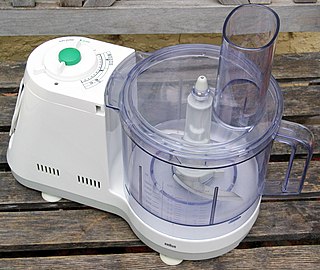
A food processor is a kitchen appliance used to facilitate repetitive tasks in the preparation of food. Today, the term almost always refers to an electric-motor-driven appliance, although there are some manual devices also referred to as "food processors".

A hot plate or hotplate is a portable self-contained tabletop small appliance cooktop that features one or more electric heating elements or gas burners. A hot plate can be used as a stand-alone appliance, but is often used as a substitute for one of the burners from an oven range or a kitchen stove. Hot plates are often used for food preparation, generally in locations where a full kitchen stove would not be convenient or practical. They can also be used as a heat source in laboratories. A hot plate can have a flat surface or round surface. Hot plates can be used for traveling or in areas without electricity.

A chuckwagon or chuck wagon is a horse-drawn wagon operating as a mobile field kitchen and frequently covered with a white tarp, also called a camp wagon or round-up wagon. It was historically used for the storage and transportation of food and cooking equipment on the prairies of the United States and Canada. They were included in wagon trains for settlers and traveling workers such as cowboys or loggers. In modern times, chuckwagons feature in special cooking competitions and events. Chuckwagons are also used in a type of competition known as chuckwagon racing.
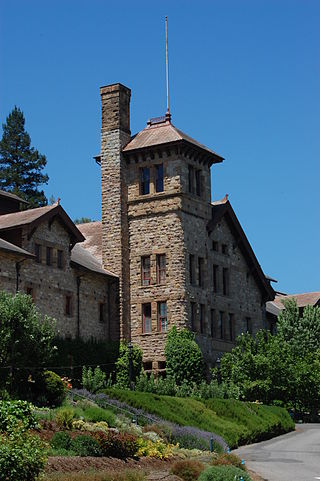
The Culinary Institute of America at Greystone is a branch campus of the private culinary college the Culinary Institute of America. The Greystone campus, located on State Route 29/128 in St. Helena, California, offers associate degrees and two certificate programs in culinary arts and baking and pastry arts. The CIA at Greystone and the Culinary Institute of America at Copia make up the school's California branch.
KitchenAid is an American home appliance brand owned by Whirlpool Corporation. The company was started in 1919 by The Hobart Manufacturing Company to produce stand mixers; the H-5 is the first model that was introduced. The company faced competition as rivals moved into this emerging market, and introduced its trademarked silhouette in the 1930s with the model "K", the work of designer Egmont Arens. The brand's stand mixers have changed little in design since, and attachments from the model "K" onwards are compatible with the modern machines.
The Chambers stove is a generic name for several different kitchen cooking appliances sold under the Chambers brand name from 1912 to approximately 1988. Their ranges and stand-alone ovens were known for their patented insulation methods, which enabled them to cook on retained heat with the fuel turned off.
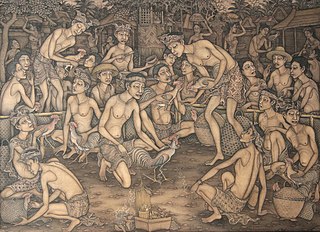
Balinese art is an art of Hindu-Javanese origin that grew from the work of artisans of the Majapahit Kingdom, with their expansion to Bali in the late 14th century. From the sixteenth until the twentieth centuries, the village of Kamasan, Klungkung, was the centre of classical Balinese art. During the first part of the twentieth century, new varieties of Balinese art developed. Since the late twentieth century, Ubud and its neighboring villages established a reputation as the center of Balinese art.
Johnny Grey is a British interior designer, author and educator, known for his work in kitchen design.
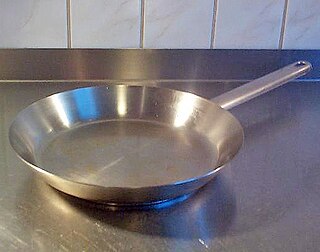
A frying pan, frypan, or skillet is a flat-bottomed pan used for frying, searing, and browning foods. It is typically 20 to 30 cm in diameter with relatively low sides that flare outwards, a long handle, and no lid. Larger pans may have a small grab handle opposite the main handle. A pan of similar dimensions, but with less flared, more vertical sides and often with a lid, is called a sauté pan. While a sauté pan can be used as a frying pan, it is designed for lower-heat cooking.

The areas of a kitchen work triangle is a concept used to determine efficient kitchen layouts that are both aesthetically pleasing and functional. The primary tasks in a home kitchen are carried out between the cook top, the sink and the refrigerator. These three points and the imaginary lines between them make up what kitchen experts call the work triangle. The idea is that when these three elements are close to one another, the kitchen will be easy and efficient to use, cutting down on wasted steps.
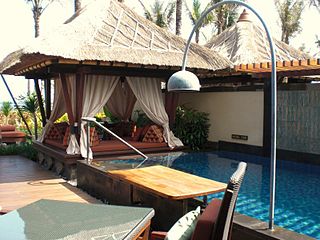
Balinese architecture is a vernacular architecture tradition of Balinese people that inhabits the volcanic island of Bali, Indonesia. Balinese architecture is a centuries-old architectural tradition influenced by Balinese culture developed from Hindu influences through ancient Javanese intermediary, as well as pre-Hindu elements of native Balinese architecture.
A demonstration kitchen, also known as a show kitchen or teaching kitchen, is a culinary space designed for cooking demonstrations, classes, and other food-related events. These kitchens are often equipped with professional-grade appliances, ample counter space, and audiovisual technology to enhance participant's learning experience.